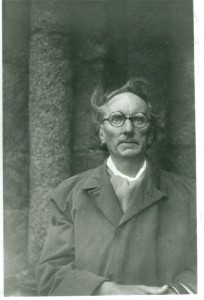About Rued Langgaard
Glimpses into the life of Rued Langgaard
Born in Copenhagen as the only child of pianist and composer Siegfried Langgaard and pianist Emma Langgaard.
Composes small piano pieces, including
Album leaf (1904).
Plays piano, violin and organ.
Receives private lessons in musical disciplines and school subjects.
Shows considerable talent for drawing and painting.
Writes short stories, often with a dramatic plot revolving around death.
Makes his debut in 1905 as organist – with improvisation thrown in – in Frederikskirken (Marmorkirken), Copenhagen.
The young Langgaard’s high musical level amazes the audience, which includes Edvard Grieg.
Composition lessons with his father Siegfried Langgaard and for a short period also counterpoint lessons with Carl Nielsen.
Composes shorter orchestral works with and without choir, songs and piano pieces, such as
Nat paa Sundet and Paa en Kirkegaard ved Nat.
Assistant organist at Frederikskirken (Marmorkirken), Copenhagen.
Applies for numerous organist positions, but although highly qualified, he is rejected time and time again.
Concert in Berlin with the Berliner Philharmoniker.
Exclusively with music by Rued Langgaard.
Enthusiastic reviews.
Falls in love with a girl named Dora during a summer stay in Kyrkhult, Blekinge.
Siegfried Langgaard dies.
Rued continues to live with his mother until her death in 1926.
Makes his conducting debut at a concert in Musikforeningen, Copenhagen.
Since then conducts occasionally (mainly his own works).
Mental health crisis.
Stay at a bathing sanatorium in Tyringe, Skåne.
Composes the theosophically inspired Sinfonia interna and the visionary Sfærernes Musik for orchestra, remote orchestra, choir and vocal soloist.
Also composes Summer Vacation in Blekinge, with memories of stays in the spa town of Kyrkhult, where Rued Langgaard spent his summer vacation in the years (1909-10 and 1912-13)
During a visit to Venice, Rued Langgaard got his first inspiration for the opera Antichrist, and he began composing Afgrundsmusik, initially titled Lagunarisk Serenade (to St. Johannes Aabenbaring).
Completes the opera Antikrist, which is submitted to Det Kgl.
Theater but never accepted for performance.
As a result of the rejection, Langgaard returns to Antikrist again and again to compose new versions of the work.
Marries Valborg Constance Olivia Tetens, her mother’s friend and maid for the previous 6 years.
Symphony No. 4 “Løvfald” is performed in a studio production by the Danish Broadcasting Corporation (Danmarks Radio) as part of a portrait broadcast in the series “Vor Tids danske Komponister”.
In the years that followed, Langgaard’s music was performed almost exclusively by the Danish Radio Symphony Orchestra (Radiosymfoniorkestret).
The conductor is usually Launy Grøndahl.
Composes the Catholic-inspired piano fantasy Adorazione in a time otherwise characterized by philosophical musings and increasing artistic isolation and compositional crisis.
Gets the only real job of his life, as organist and cantor at Ribe Cathedral.
Lives the rest of his life in Ribe, where he is soon seen as an original.
With his long uncut hair, wide-brimmed hat and stumpy trousers, he stands out noticeably in the small market town.
The move leads to a revitalization as a composer and one of the first new works composed in Ribe is Smaa Sommerminder for piano.
Composes among other things.
Madness Fantasy for piano.
With the motto “Ved “Bonn Domkirken” i Ribe”, Langgaard emphasizes that he feels a kinship with Robert Schumann, who died in an asylum for the mentally ill near Bonn.
Composes among others.
Symphony no. 15 “The Sea Storm” and Music of the Hel-spheres for piano.
In the preface to the symphony, a night walk in Ribe is compared to Orpheus’ futile journey into the realm of the dead.
The last picture taken by Langgaard is from August 1951.
Here he stands with his back to the cathedral and looks up at the sky that arches over the flat marshland towards the North Sea west of Ribe.
A month earlier, Langgaard composes Piano Piece in E Major.
Dies at Ribe Hospital on the night between
9. and
July 10th.

Photo: (“Outside the Cathedral Aug. 1951”)